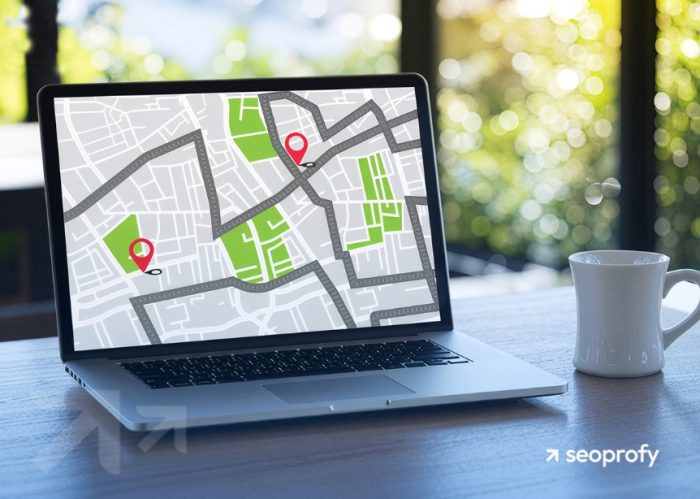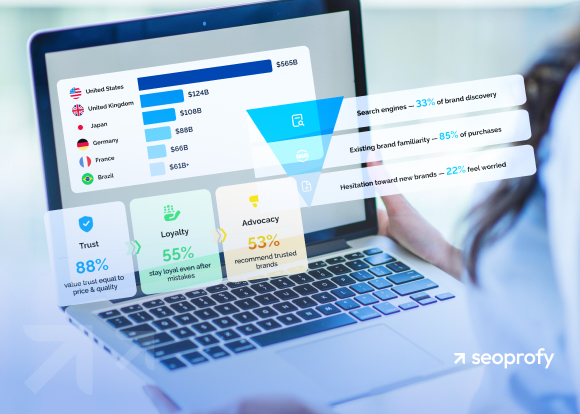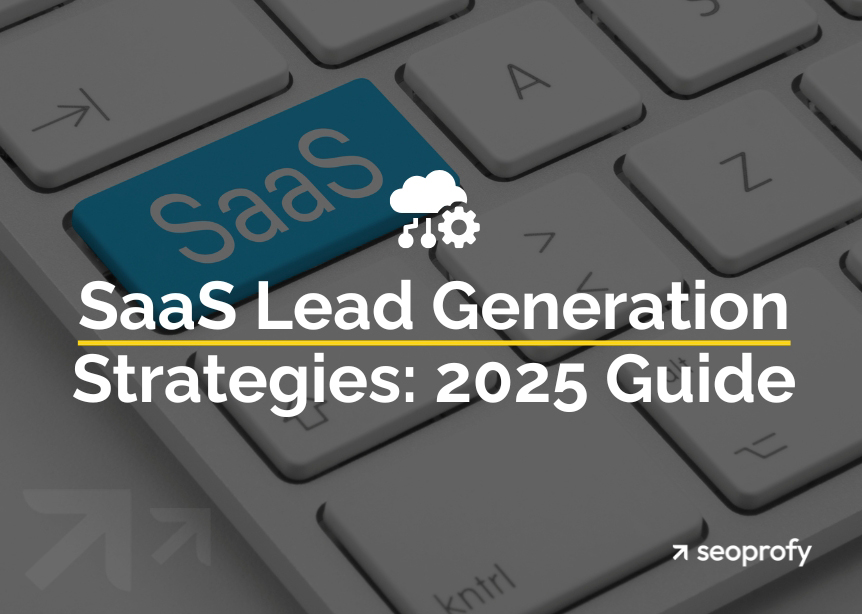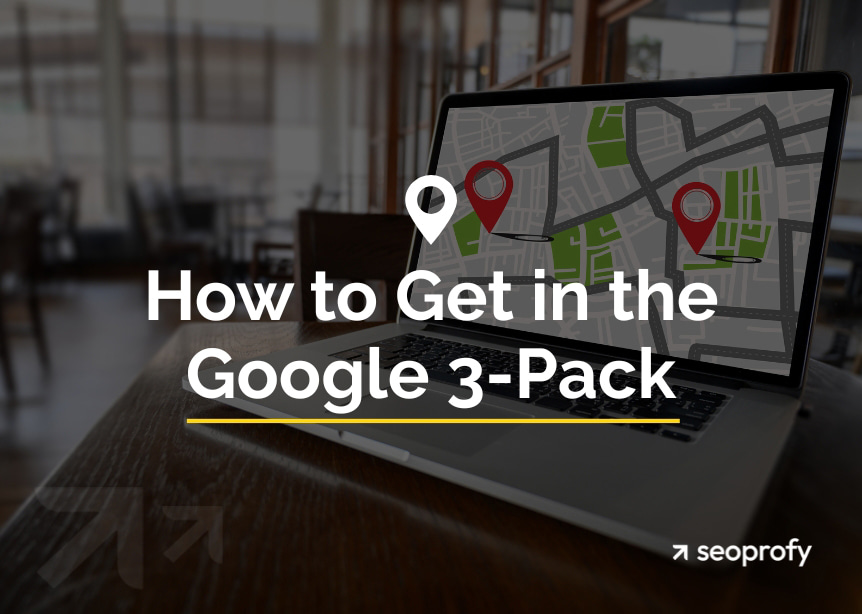Ensuring your brand’s online visibility is a cornerstone of your business success and high revenue. However, if you run a brick-and-mortar company across several regions, dealing with this task becomes a true marketing challenge. Luckily, with the efficient local SEO for multiple locations, you can easily handle any possible issues.
This bundle of efficient practices will help you reach prospective customers in any corner of the world and inspire them to purchase your services or products. Moreover, SEO will help you establish an authoritative brand, which takes into account the specific characteristics of each target region and your niche. With the help of tips provided in our guide, you can maximize your income, discover new business opportunities, and significantly improve your customers’ experience.
- Multi-location SEO focuses on improving business visibility in several target regions, considering the particularities of the local audience and trends.
- Regularly responding to your customers’ reviews improves your reputation and local search rankings.
- Using virtual offices can lead to penalties from Google.
- It’s essential to keep the same NAP information across all platforms if you don’t want the algorithms to suspect you of providing inaccurate details about your business.
What Is Multi-location SEO?
SEO for multi-location businesses is the optimization of a company’s online presence to increase its visibility and rankings in local search queries. Consider that 96% of modern consumers discover information about the shops and companies near them through online searches. At the same time, only 9% of users scroll all the way to the bottom of the first page of Google.
Thus, keeping high rankings in local search results is essential for attracting more organic traffic and converting it into loyal customers. Nonetheless, businesses with multiple locations need more advanced SEO strategies, as it’s necessary to consider the particularities of diverse audiences and regions.
For example, H&M runs several businesses in Irving, so the company has to manage a Google Business Profile for each of its stores. Moreover, it’s also necessary to analyze audience behavior and needs in each city area, track local events, and monitor trends to stay ahead of the competition.
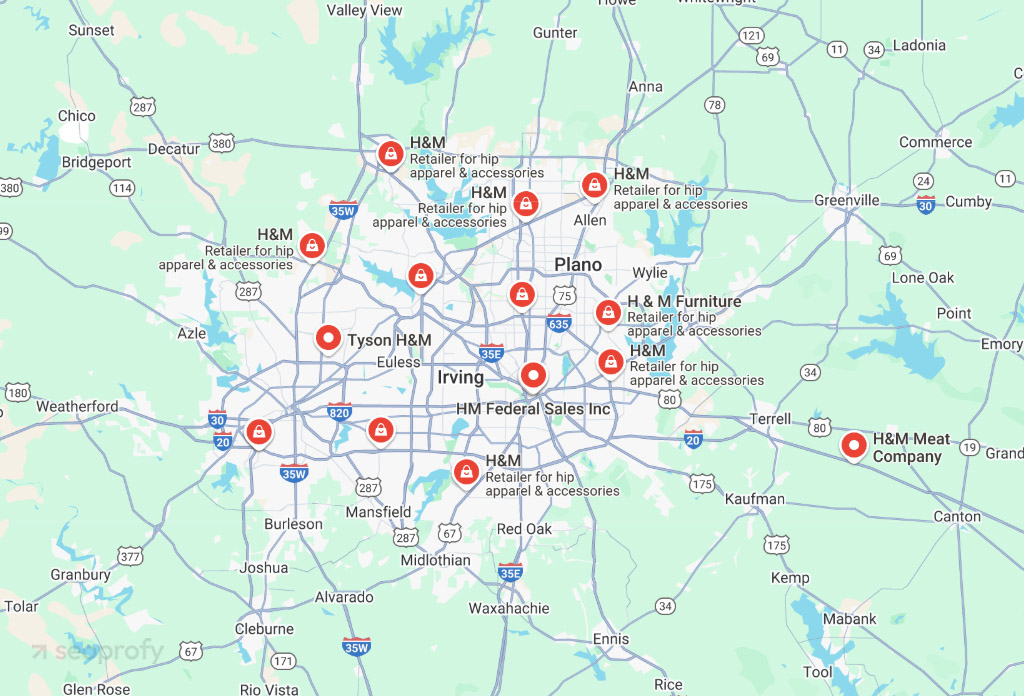
Of course, it’s difficult to manage such a great number of stores, and that’s where local seo for multiple locations comes in! Thanks to a well-planned strategy, you can hit your business goals, including:
- Boost sales and attract new customers in each particular location
- Enhance your Business Profiles
- Get more positive reviews
- Track and improve your business progress
Also, if you run a company operating in several countries, you must surely opt for international SEO practices. With these techniques, you can easily skyrocket your brand and enter the global market.
The Basis For Multi-location SEO Optimization
This type of SEO involves several processes that aim to improve the website’s overall performance. However, some elements require separate attention, as they play the most significant role in your site’s ranking in both regular local organic results and the Map Pack.
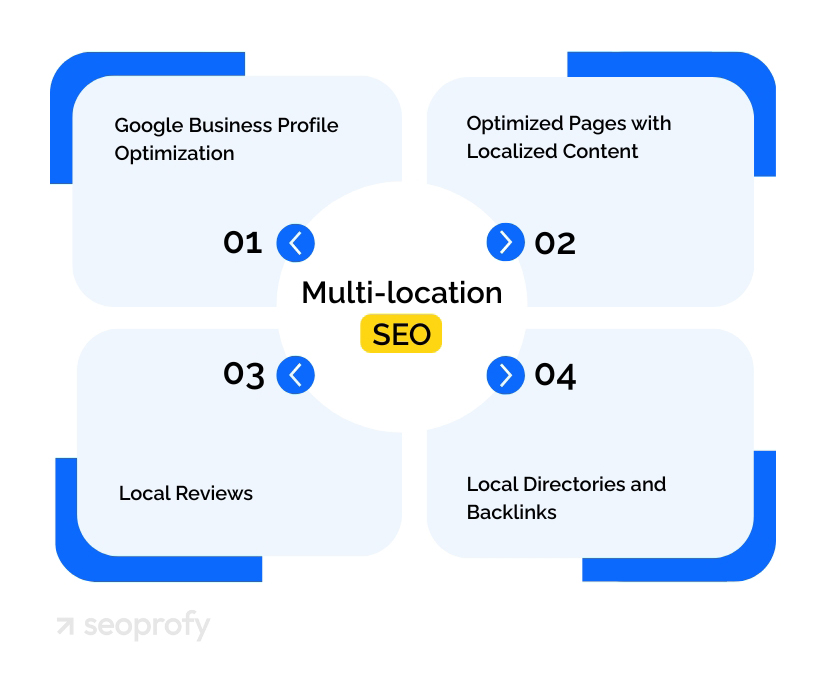
Google Business Profile Optimization
Google Business Profile (GBP) is a powerful, free tool that allows you to control how your company appears on Google Maps, Search, and Shopping. It allows you to provide your clients with essential information about your organization, including business hours, address, phone number, and website:
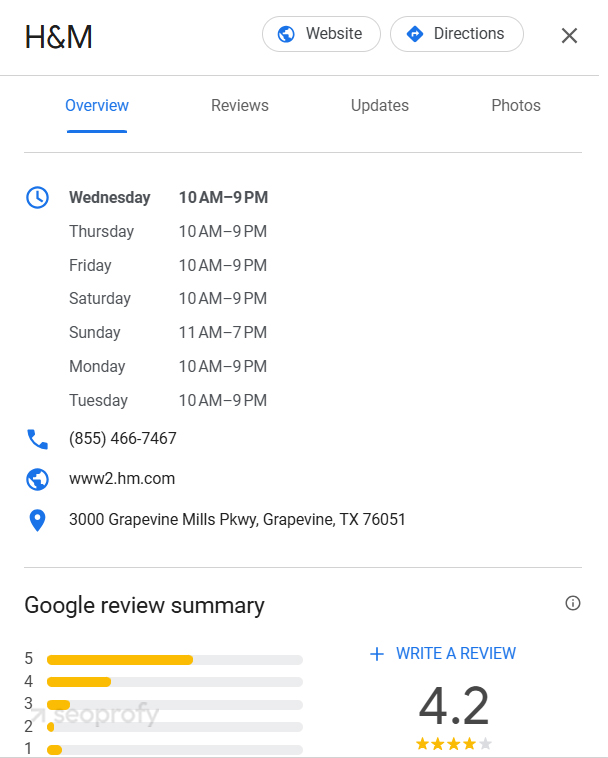
Optimized Pages with Localized Content
A business with hundreds of brick-and-mortar stores or companies may have hundreds of location landing pages. Each of them must contain information important to the audience from the specific geographic area where you sell your products or services.
Moreover, they must include localized content. It means that an average customer from a certain area should be able to easily understand blog posts, business information, and product pages. Content localization includes both text translation for multilingual markets and regional adaptation within the same language. It’s important to adjust tone, terminology, and details to reflect local culture, such as using regional expressions, mentioning nearby landmarks, or events.
Local Reviews
Local reviews are important not only for your business reputation but also for online visibility. Consider that 90% of marketers believe that they have a direct impact on rankings in the local pack. Thus, you should always inspire your local customers to leave feedback and respond to each review, regardless of whether it’s positive or negative.
Structured Data
To improve the visibility of your location pages in search results, it’s essential to implement structured data using the LocalBusiness schema. This code helps search engines understand key details like addresses, phone numbers, and business hours for each location. Adding structured data to your location pages increases the chances of showing up in rich results, such as Map Packs or enhanced listings, which can drive more traffic and engagement.
Local Directories and Backlinks
If you want to create an SEO strategy that will ensure your business’s success, don’t forget to look for relevant online directories where you can list your company or shop. These online resources will not only provide you with valuable backlinks but also help you draw your potential customers’ attention. Consider that the choice of directories directly depends on your business type and target location. For example, if you run a restaurant in New York, you may be interested in getting listed by OpenTable, Eater NY, or Resy NY.
How to Do Multi-Location SEO: 8 Best Practices
Now, let’s get to SEO best practices that will take your business to the next level. Their implementation, combined with high-quality content and an outstanding website’s performance, will ensure growth in your organic traffic, eventually leading to higher sales.
For example, it’s necessary to use geo-specific keywords for each page to maintain growing rankings. With the help of Ahrefs, you can discover these terms and weave them into your content. Here, you can see how this powerful tool discovers the keywords related to “cleaning services in”:
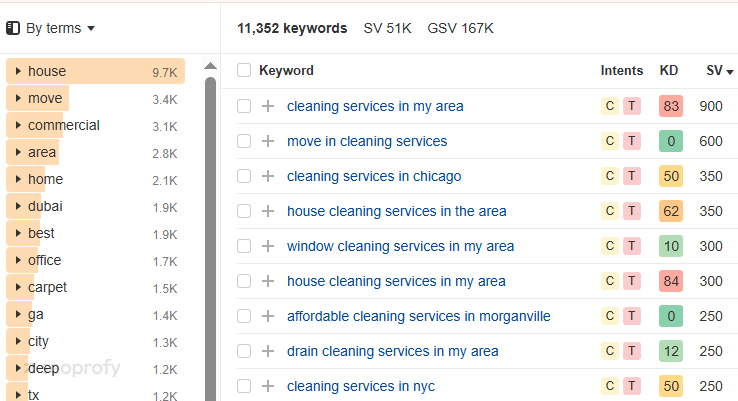
Although Ahrefs discovered over 11,000 results, it doesn’t mean you need to use all of them. Focus only on the general keywords (e.g., “cleaning services in my area”) and the ones related to your target area (e.g., “cleaning services in Chicago”).
Also, there are other important techniques you can implement to boost your multi-location business. The efficient implementation of these methods will help you not only to grow your rankings but also ensure better interaction with local communities.
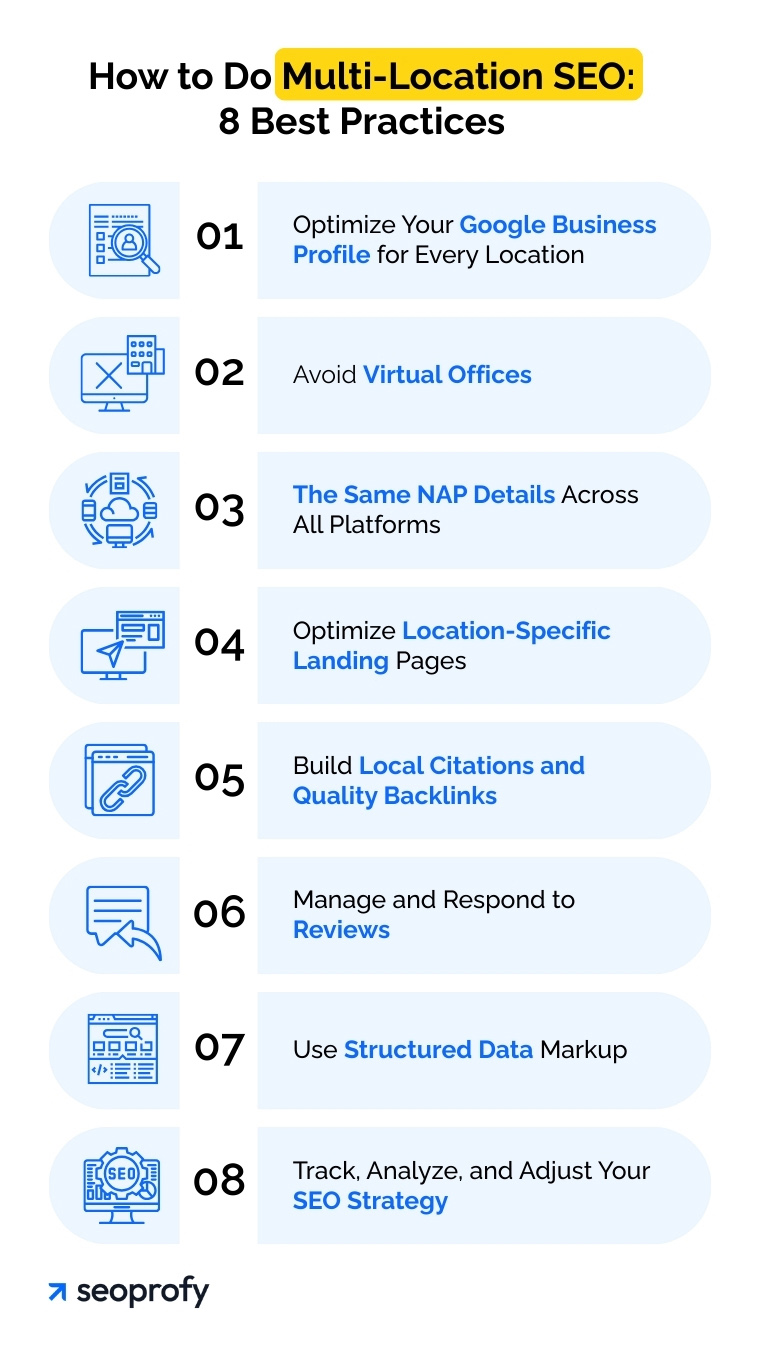
1. Optimize Your Google Business Profile for Every Location
We already introduced you to the GBP basics, and now let us provide you with the expert tips for its optimization. First, ensure that each of your brick-and-mortar businesses has its own Google Business Profile. If you’ve noticed one of your shops or companies needs a GBP, you can create it here.
Also, if you already have Google Business Profiles, it’s a good idea to check them again. During this examination, pay attention to the following elements:
- Images: High-resolution quality photos play a key role in showcasing your business to potential customers and enhancing its position in the local pack. You can provide the images of the storefront, interior, products, or the results of your services.
- Information accuracy: It’s essential to maintain accurate information about your business. Ensure that all your GBPs include relevant details, such as name, address, and phone numbers (NAPs). Additionally, provide information about business hours and website URLs that lead directly to the relevant local pages on your site.
- Reviews: As we have mentioned, it’s important to respond to all types of reviews if you want to show Google’s algorithms that you actively interact with your audience. Plus, according to our local statistics, 89% of customers are more likely to opt for a business that responds to all reviews. Thus, managing your consumers’ feedback is extremely important for both your rankings and reputation.
After checking and optimizing all these elements, each of your Google Business Profiles should look like the one run by the Target store in Long Beach:
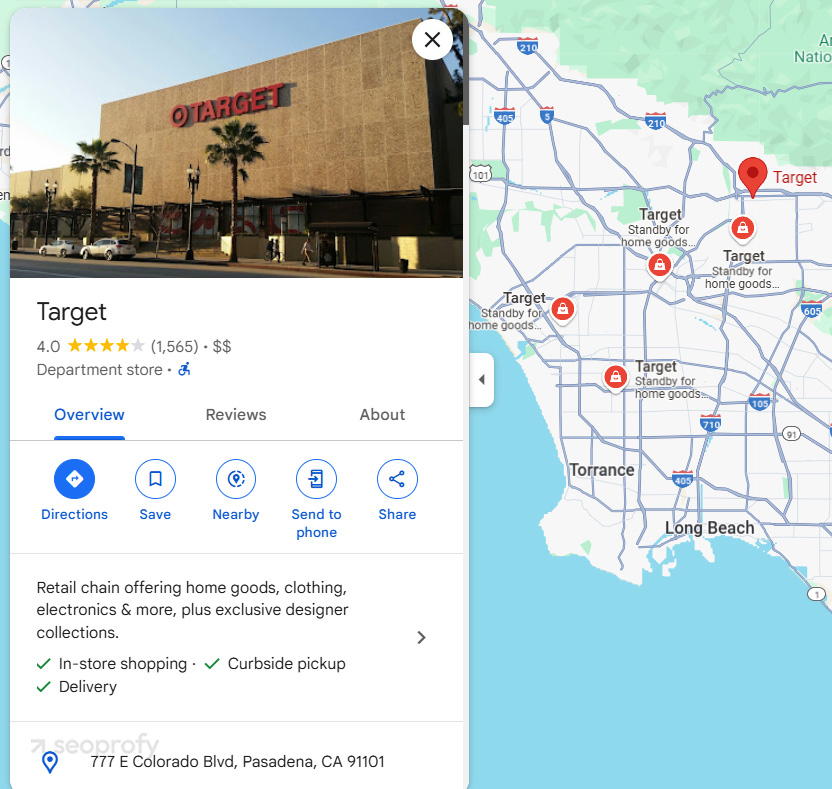
Also, it’s extremely important to keep your GBPs active by regularly updating information about your businesses. For example, it’ll be a wise decision to post promotions, news, and events related to each specific location to keep your audience engaged.
Of course, you may think that it’s almost impossible to optimize all profiles if you own dozens of brick-and-mortar shops. Luckily, the Google Business Profile Manager allows you to add managers or other team members to help with administration tasks. You can send an invitation via the Group Locations settings page.
2. Avoid Virtual Offices
Some businesses purchase so-called “virtual offices” to use their addresses in their Google Business Profiles. Nonetheless, consider that using this technique for multi-location local SEO will surely lead to the violation of Google’s guidelines:

Additionally, Google will ask you to verify your business address, and failure to meet eligibility criteria can result in suspension or removal of your listing. This potentially may undo your previous local SEO efforts.
3. The Same NAP Details Across All Platforms
NAP consistency is another important factor to consider while developing your multiple location SEO strategy. Google regularly analyzes various sources about your shop or company to ensure you’ve provided accurate and trustworthy details about it. Thus, if various location pages, citations, and review sites include different information, the algorithms will have low trust in your business. Eventually, Google will lower your website’s rankings.
When optimizing your local businesses, look across all directories that mention them. Moreover, it’s not only enough to ensure that both name and phone number are correct. When it comes to your business address, check whether the abbreviations of the street name are the same everywhere.
Google won’t like it if one directory lists the address as “134 Main St. #15” while another lists it as “134 Main Street, Suite 15”. For example, Domino’s Pizza maintains the same naming format for all its Chicago locations, reinforcing brand trust. At the same time, each listing has a unique address and phone number, confirming they are distinct storefronts.
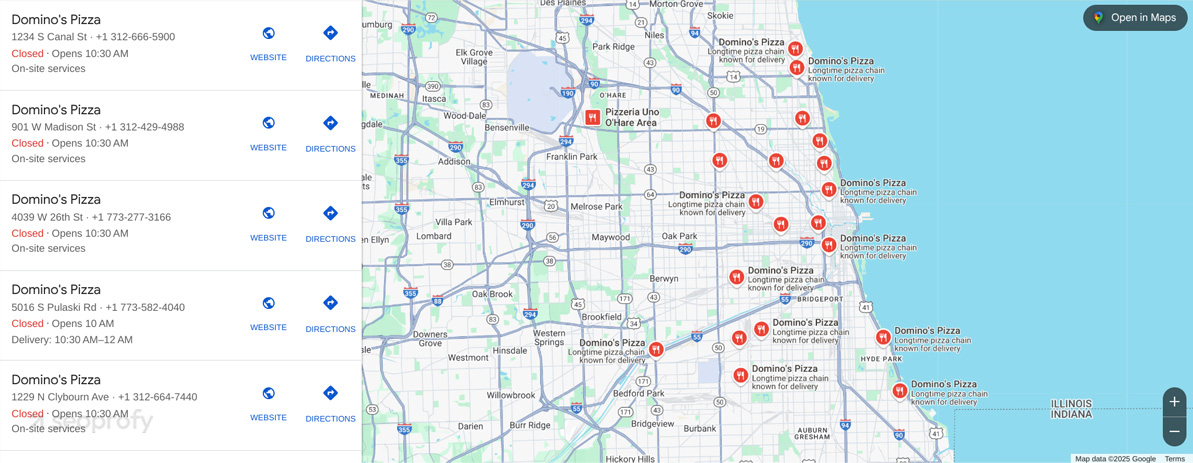
4. Optimize Location-Specific Landing Pages
Create separate pages dedicated to different locations (so-called “hyperlocals”) on your website. Each of them should include metadata related to the target area. For instance, The Maids’ website has a separate page for each region where it provides its services. On the screenshot, you can see that the URL, Title, and Description include the keywords related to the target region (“Morganville” and “NJ”):
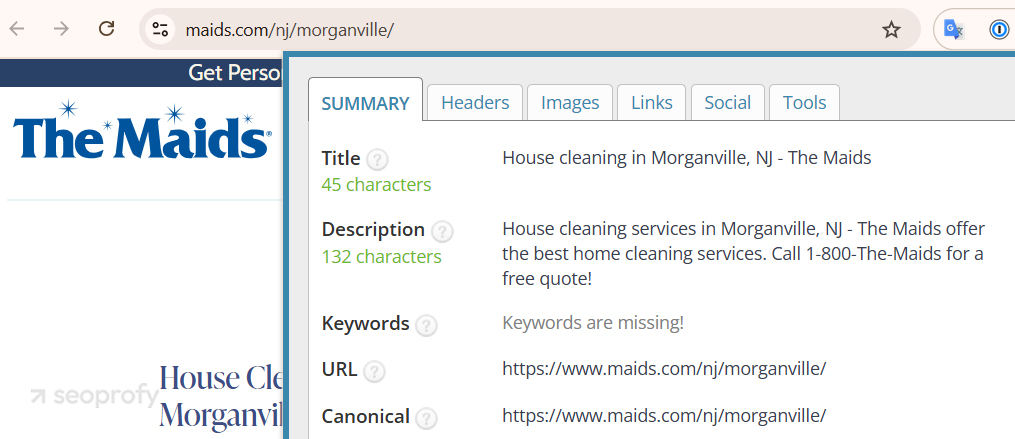
Plus, you can boost your multi-location SEO by adding business-specific information to the Description, such as the phone number. As a result, users will be able to see it directly in Google Search.
When it comes to content, you need to tailor it to the target location, efficiently incorporating local keywords. They will help your pages rank for search queries relevant to the particular area. Also, you may add details about the services or products offered at that location, maps, contact information, parking availability, etc.
Finally, include customer testimonials or case studies. Thus, you can enhance your credibility and inspire consumers to make a purchase.
Opt for our custom multi-location SEO strategies to boost your business! With SeoProfy, you can reach success in any corner of the world, receive:
- Improved user experience
- Establishment of a popular brand
- Increased sales and ROI
- Enhanced authority in each location

5. Build Local Citations and Quality Backlinks
A strong backlink profile is undoubtedly one of the most important ranking factors. Obtaining links from reputable local websites will help you boost your authority and increase your pages’ positions on search engines. Here are some local link building techniques you can use to improve your business:
- Local citations: The services, such as Yelp and Yellow Pages, help Google associate your business with the areas where it operates. If you want to discover these websites, you can simply enter the keyword related to your business and location. For example, if you run cleaning services in Morganville, you can simply look for “affordable cleaning services in Morganville.” Thus, you’ll see the websites listing the best house cleaners in the area:
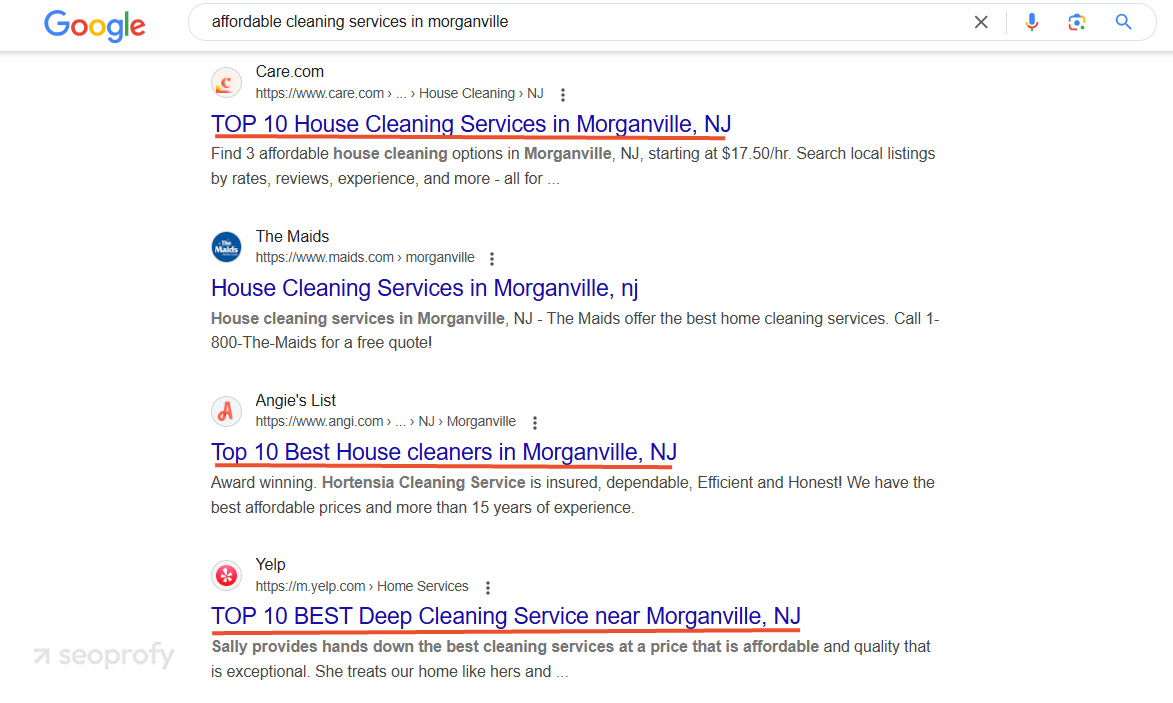
- Micro-influencers: SEO strategies for multiple locations often involve interaction with the regional micro-influencers. As a rule, they interact with people from a certain city or region. Being mentioned in their blogs will surely help you draw the attention of the target audience and, at the same time, can improve your backlink profile.
- Local news: You may participate, sponsor, or even organize local events. Thanks to this activity, you won’t just interact with the community, but you could also be mentioned by news websites.
It’s truly challenging to get local backlinks when you run a multi-location business. You need to implement the mentioned techniques across all your target regions, but as a result, you’ll significantly skyrocket your revenue and authority.
6. Manage and Respond to Reviews
We’ve already mentioned the necessity to respond to your customers’ feedback, both positive and negative. In addition to their direct influence on your reputation, reviews are also among the major ranking factors. The algorithms consider their number, keywords in them, and the described client’s experience to estimate your business’s truthworthiness.
It’s essential to make a review collection part of your multi-location SEO strategy. And the best way to inspire your client to leave positive feedback is to ensure their satisfaction with your services or products. Also, you can use Local Services Ads to generate a Customer Reviews link and provide clients with it after their first visit to your brick-and-mortar businesses.
Once you get feedback, don’t forget to respond to it ASAP. Thus, you won’t simply show you take care of your customers’ experience, but also keep your GBP active. If it’s possible, try to make your responses more personal by including the client’s name. Here is a great example from the owner of Shorely Clean:
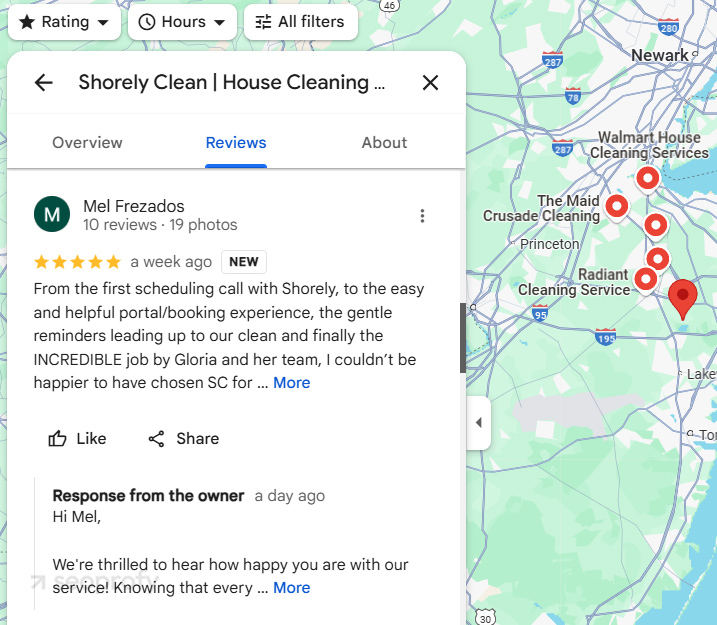
Also, consider that your overall rate also matters. Getting reviews higher than 4 stars significantly strengthens your chances of getting in the Google 3-Pack. This list includes the three most popular businesses from a legal niche within the Washington area:
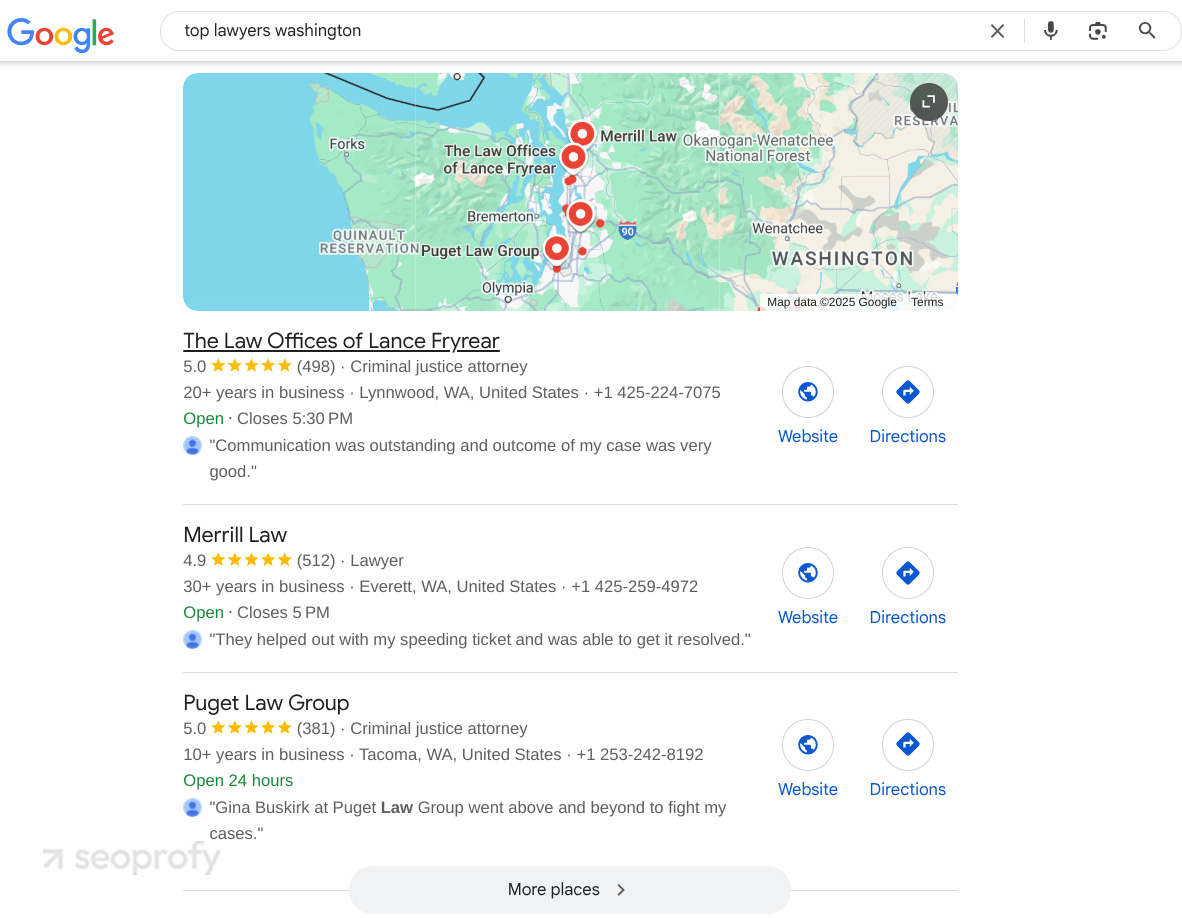
When a user includes “best” or “top” in their query, Google’s algorithms often show the results with a more than 3.7-star rating. Thus, if you don’t have enough positive reviews, it’s a clear signal that you need to track clients more thoroughly, pay attention to their needs, and focus more on delivering a better experience.
We’d like to point out that if your business locations are in multiple countries, you definitely need to opt for multilingual SEO to improve your authority. Providing content and product descriptions in your potential clients’ language will surely improve their experience and make your store or company appear “more local.”
7. Use Structured Data Markup
On-page SEO for multi-location businesses involves a range of techniques to improve each page’s visibility in specific regions. One essential step is using structured data markup to help search algorithms understand key details about each location, including the address, business hours, phone number, and reviews. This improves how your business appears in search results and can lead to higher click-through rates (CTRs).
To deal with this task, check every page on your website, focusing on title tags, meta descriptions, and H1 headings. Ensure that each of these elements contains location-specific keywords. Also, you can use Google’s structured data markup helper to tell its algorithms more about each page.
Of course, efficient optimization requires a lot of specific knowledge and experience. Thus, you can simply rely on our local SEO services, and we’ll make your business flourish in all your target areas.
8. Track, Analyze, and Adjust Your SEO Strategy
It’s not enough just to implement SEO for multiple locations and forget about further improvement of your GBP or local pages. Search engines constantly evolve, and new trends appear. Thus, you should always be ready to adjust your website accordingly.
Using Google Analytics and Google Search Console, you can track the performance of all your pages. Also, you can opt for more advanced AI SEO tools like Semrush and Ahrefs to monitor your competitors and spot new trends. During your analysis, focus on the key metrics, such as:
- Organic traffic: It shows the number of visitors who enter your website from unpaid search engine results.
- Rankings: This metric reflects a website’s position in the search engine results page for certain keywords.
- User behavior: It demonstrates the user’s actions, including the click-through rate, bounce rate, conversions, and more.
Careful website audit and analysis of the mentioned metrics will help you spot any serious issues beforehand and fix them as soon as possible. Thus, your business will always stay on top of local search engine optimization trends across different places.
Common Pitfalls and Challenges
Even after implementing the mentioned techniques, you may still face problems like Google Business Profile not showing for a specific location or your rankings not growing. First, keep in mind that SEO takes time to yield results, so you may need to wait at least six months before you see improvements.
Of course, managing businesses in several regions is extremely difficult in terms of marketing. While optimizing your pages, you may face the following problems:
- Link building challenges: Depending on the target region, it can be difficult to find local influencers who are eager to provide quality backlinks. In this case, focus on popular blogs and sites related to your niche that reach a wider audience. For example, instead of a microblogger from the target city, you may get in touch with an influencer popular in the entire state.
- Geo-specific content: Crafting unique and valuable content for each location is extremely challenging, as it requires constant research. You need to keep an eye on trends and news in each target area, so you can use them to generate ideas for your blog posts.
- Competition: In addition to local brands, you’ll also need to compete with the national ones. Thus, it’s extremely important to develop an SEO strategy that considers keywords and trends related not only to your target region but also to your niche.
Still, these challenges are not insurmountable. With the right expertise, tools, and strategy, even the most complex multiple-location SEO issues can be overcome.
You’re welcome to get acquainted with our SEO case studies, which also include our partnership with multi-location businesses. For example, due to our team’s expertise in local SEO techniques and the implementation of our unique in-house tools, we helped one of our clients recover from the September 2023 Helpful Content Update. Moreover, in several months, our client reached a 500% growth in organic traffic, which led to increased revenue and brand awareness across multiple regions.

Let’s Build a Multi-Location SEO Strategy for Your Businesses
Running multiple company units or shops is extremely challenging as it requires active participation in the lives of several communities. Depending on your business scale, you may need to respond to hundreds of reviews daily, monitor numerous news sources, and engage with dozens of influencers.
Luckily, SeoProfy is always ready to lend a helping hand. While our experts take care of your local SEO campaign, you can focus on improving your services or products to ensure a better customer experience and grow your revenue.

